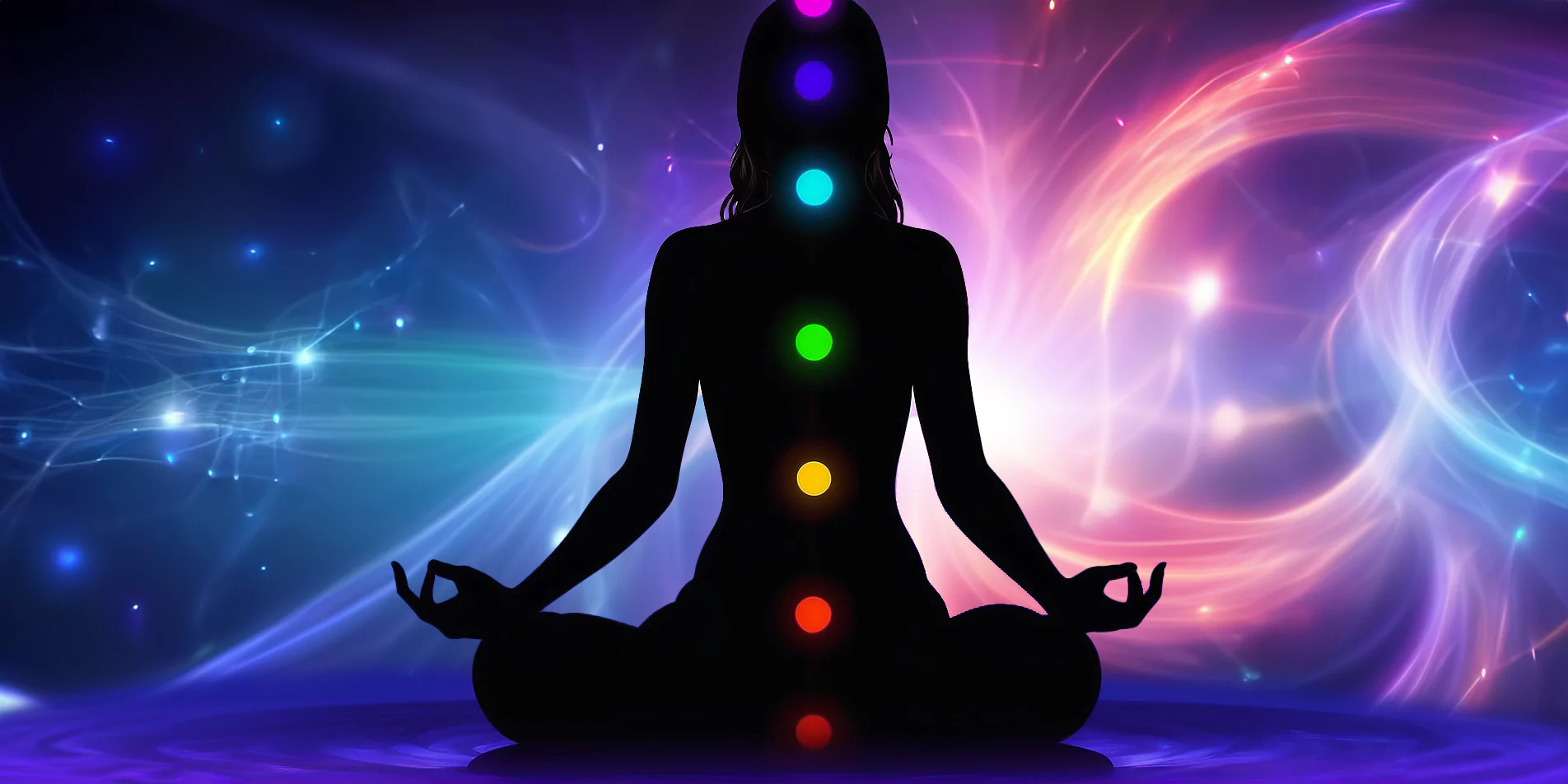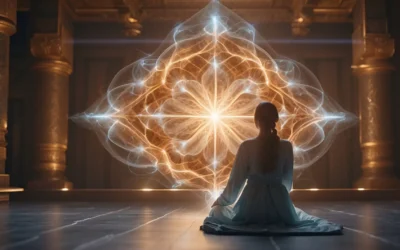Chakras, the energy centers within our bodies, are pivotal to our overall well-being. Understanding the chakra system can lead to a balanced and harmonious life. These main chakras, including the root chakra, sacral chakra, solar plexus chakra, heart chakra, throat chakra, third eye chakra, and crown chakra play a crucial role in regulating the flow of energy through our bodies. They are intricately connected to our nervous system and various organs. By delving into these particular chakras and their associated mantras, one can tap into intuition and align their spirit with an optimal energy flow along the spine.
- Origins and History of the 7 Chakras
- Understanding Each Chakra’s Function and Symbolism
- Signs of Blocked or Unbalanced Chakras
- Techniques for Diagnosing Chakra Imbalances
- Methods to Unblock and Balance Chakras
- Lifestyle and Practices for Chakra Maintenance
- The Role of Chakras in Health and Well-being
- Advanced Concepts in Chakra Healing
- Conclusion: Embracing Chakra Balance for Holistic Health
- Frequently Asked Questions
Origins and History of the 7 Chakras
Ancient Origins
The concept of chakras has its roots in ancient India, where it is deeply ingrained in traditional spiritual practices. The word “chakra” itself comes from Sanskrit, an ancient Indo-European language used in Hindu scriptures. These energy centers have been referenced in Hindu texts for centuries, with their significance deeply woven into various aspects of Indian culture and spirituality. The understanding of chakras as energy centers within the body has evolved over time. Initially mentioned in early Vedic texts, including the Yoga Upanishads and the Yoga Sutras of Patanjali, these references laid the foundation for further exploration and development of this concept.
Evolution Over Time
Over time, the knowledge about chakras expanded beyond religious contexts to encompass broader spiritual philosophies and alternative healing practices. This evolution led to a more comprehensive understanding of each chakra’s unique attributes and how they interact with one another within the human body. For example:
- The root chakra, located at the base of the spine, represents stability and security.
- The heart chakra, situated at the center of the chest, symbolizes love and compassion.
- The throat chakra governs communication and self-expression.
- The eye chakra, also known as the third eye or brow chakra, relates to intuition and insight.
- The sacral chakra, positioned in the lower abdomen area, embodies creativity and passion.
- The solar plexus chakra, found near the stomach region, influences personal power and self-esteem.
- Lastly, we have the crown chakra at the top of our head that signifies spiritual connection.
This detailed comprehension paved the way for diverse applications such as yoga therapy sessions focused on balancing specific chakras through poses (asanas), and meditation techniques targeted at aligning these energy centers for overall well-being.
Understanding Each Chakra’s Function and Symbolism
Root Chakra
The root chakra is all about stability and security. It’s located at the base of the spine, symbolizing our foundation. This chakra governs our basic needs such as food, shelter, and safety. When it’s balanced, we feel grounded and secure. However, an imbalance in this chakra can lead to feelings of insecurity or instability. This chakra also influences the major organs in the body like the adrenal glands which are responsible for managing stress responses. To keep this energy center balanced, engaging in grounding activities such as walking barefoot on grass or practicing yoga poses like Tadasana (Mountain Pose) can be helpful.
Heart Chakra
The heart chakra, located at the center of the chest, is associated with love, compassion, and emotional balance. When this chakra is in harmony, we feel a deep sense of love for ourselves and others, and we are able to form healthy, meaningful relationships. An imbalance in this chakra can lead to feelings of loneliness, bitterness, or jealousy. Practices such as self-love exercises, forgiveness meditation, and engaging in acts of kindness can help in balancing the heart chakra.
Throat Chakra
The throat chakra is positioned at the base of the throat and is linked to communication and self-expression. When this chakra is balanced, we can express ourselves clearly and honestly. An imbalance in this chakra can manifest as difficulty in speaking our truth or fear of judgment. Singing, journaling, and practicing mindful speech can help in balancing the throat chakra.
Eye Chakra
The eye chakra, also known as the third eye, is located between the eyebrows and is associated with intuition and insight. When this chakra is open and aligned, we experience heightened intuition and clarity of thought. Imbalance in this chakra can lead to feelings of confusion or lack of direction. Meditation, visualization exercises, and spending time in nature can help in balancing the eye chakra.
Sacral Chakra
The sacral chakra, positioned in the lower abdomen, is linked to creativity, sexuality, and emotional well-being. When this chakra is balanced, we feel a sense of passion and creativity in our lives. An imbalance in this chakra can lead to issues with intimacy or creative blocks. Engaging in creative activities, practicing mindfulness, and connecting with others can help in balancing the sacral chakra.
Solar Plexus Chakra
The solar plexus chakra is located in the upper abdomen and is associated with personal power and self-esteem. When this chakra is balanced, we feel confident and in control of our lives. It’s like having a superhero power that helps us stand tall and feel brave! When the solar plexus chakra is imbalanced, we may feel a lack of confidence, struggle with making decisions, and experience low self-esteem. This imbalance can also manifest physically, leading to digestive issues and stomach problems. Engaging in activities that boost self-confidence, such as yoga or meditation, can help realign this chakra.
Crown Chakra
At the top of our head lies the crown chakra, associated with spirituality and enlightenment. It represents our spiritual connection to something greater than ourselves – a sense of divine purpose beyond material existence. When this chakra is open and aligned, we experience a profound connection to our higher self and universal consciousness. The crown chakra is linked to the pituitary gland which regulates hormones affecting growth, blood pressure regulation, and metabolism control among others. Meditation plays a crucial role in balancing this energy center; it helps quieten the mind allowing us to connect with our inner selves more deeply. By understanding each chakra’s function and symbolism – from representing stability at the root level to connecting with spirituality at its peak – individuals can work towards achieving balance within themselves.
Signs of Blocked or Unbalanced Chakras
Physical Symptoms
When our chakras are blocked or unbalanced, they can manifest physical symptoms. For instance, a blockage in the root chakra may lead to issues like lower back pain, constipation, or even problems with the legs and feet. Similarly, an imbalance in the throat chakra might result in frequent sore throats or neck pain. These physical signs serve as crucial indicators of potential chakra imbalances that need attention. The solar plexus chakra is associated with self-esteem and confidence. If it’s blocked or unbalanced, you might experience digestive issues like stomach ulcers or difficulty gaining weight. On the other hand, an overactive solar plexus chakra could lead to aggressive behavior and control-related problems.
Emotional and Mental Symptoms
In addition to physical manifestations, chakra imbalances can also surface through emotional and mental symptoms. For instance, individuals with a blocked heart chakra may struggle with feelings of loneliness and despair while those dealing with an overactive heart chakra might exhibit co-dependency tendencies. Moreover, anxiety is often linked to an imbalance in the solar plexus chakra, while depression can be indicative of a problem within the root chakra. Furthermore, anger management issues could stem from imbalances within the sacral chakra, which governs emotions related to pleasure and creativity.
Recognizing these Signs
Recognizing these signs is vital for addressing any existing imbalances within our chakras. By paying attention to these indications – whether they’re physical discomforts like headaches (associated with third eye charka) or emotional struggles such as lack of motivation (linked to sacral charka) – we become more equipped at identifying areas where our energy centers may need realignment. Understanding how each symptom corresponds to a specific chakra allows us not only to identify potential blockages but also empowers us to take appropriate steps for healing and balancing them.
Techniques for Diagnosing Chakra Imbalances
Meditation and Self-Reflection
Meditation is a powerful tool for diagnosing chakra imbalances. By focusing on each chakra during meditation, individuals can sense any blockages or disturbances in the flow of energy. During this process, paying attention to physical sensations and emotions associated with each chakra helps identify areas of imbalance. Similarly, self-reflection allows individuals to introspect and recognize patterns of behavior or thought that may indicate chakra imbalances. For example:
- While meditating on the heart chakra, one might feel tightness in the chest or experience feelings of sadness, potentially indicating an imbalance in this area.
- Through self-reflection, someone might realize a pattern of difficulty expressing themselves honestly and openly, signaling a potential blockage in the throat chakra.
Seeking Guidance from Energy Healers or Holistic Practitioners
Seeking guidance from experienced energy healers or holistic practitioners can provide valuable insights into chakra imbalances. These professionals are adept at detecting subtle energy disruptions within the body’s chakras through various techniques such as Reiki healing, crystal therapy, and aura readings. Their expertise enables them to identify specific areas of concern and offer tailored solutions for realigning the chakras. Energy healers often use tools like crystals or pendulums to detect irregularities in energy flow within the chakras. Holistic practitioners may conduct thorough assessments involving discussions about emotional well-being and physical symptoms related to each chakra, leading to a comprehensive diagnosis.
Understanding Specific Symptoms Related to Each Chakra
Understanding the specific symptoms related to each chakra is crucial for accurate diagnosis. For instance:
- The root chakra (Muladhara) governs feelings of security and stability; therefore, signs of insecurity or financial stress could indicate an imbalance here.
- The sacral chakra (Svadhisthana) influences creativity and emotional balance; hence experiencing creative blocks or volatile emotions may suggest an issue with this chakra.
- The solar plexus (Manipura) is associated with personal power and self-esteem; therefore, persistent feelings of inadequacy or lack of confidence may point towards an imbalance in this area.
Methods to Unblock and Balance Chakras
Meditation, Yoga, and Breathwork
Meditation, yoga, and breathwork are powerful methods for unblocking the chakras. Through meditation, individuals can focus on each chakra’s energy flow, visualize its balance, and use affirmations to restore harmony. Similarly, yoga postures help release any blockages in specific chakras by stretching and strengthening the associated muscles. Breathwork techniques like pranayama can cleanse the energetic pathways of the chakras by regulating the flow of life force or “prana.” These practices not only address physical tension but also enhance mental clarity while promoting emotional stability. For example:
- Sitting cross-legged with closed eyes during meditation helps in focusing on individual chakras.
- Practicing yoga poses such as cobra pose (Bhujangasana) or bridge pose (Setu Bandhasana) specifically targets certain chakras.
Crystals, Sound Therapy, and Aromatherapy
Using crystals, Solfeggio Frequencies sound therapy, and aromatherapy is another effective approach to restoring balance within the chakras. Different crystals are associated with each chakra; placing these crystals on corresponding body parts can help clear energy blockages. Likewise, sound therapy involving instruments like singing bowls or tuning forks creates vibrations that resonate with specific frequencies related to each chakra’s optimal state.
Chakra | Solfeggio Frequency |
|---|---|
Root | 396 Hz |
Sacral | 417 Hz |
Solar Plexus | 528 Hz |
Heart | 639 Hz |
Throat | 741 Hz |
Third Eye | 852 Hz |
Crown | 963 Hz |
Moreover, aromatherapy utilizes essential oils derived from plants known for their healing properties. Inhaling these scents can influence one’s mood and emotional well-being while stimulating particular chakras for balancing purposes. For instance:
- Placing amethyst near the crown chakra aids in spiritual growth.
- Using rose oil for heart-centered practices supports the opening of the heart chakra.
Regular Practice Promotes Overall Well-being Consistent practice of these various methods not only unblocks and balances the individual chakras but also contributes to overall well-being – physically, mentally, emotionally, and spiritually.
- Regular meditation fosters a sense of inner peace while enhancing self-awareness.
- Engaging in crystal healing sessions periodically maintains energetic equilibrium within all seven major chakras.
Incorporating these diverse approaches into daily routines or seeking guidance from holistic practitioners when needed ensures a harmonious flow of vital energy throughout our bodies.
Lifestyle and Practices for Chakra Maintenance
Supporting Balanced Chakras
Maintaining a healthy lifestyle is essential for supporting balanced chakras. This involves consuming a nutritious diet, engaging in regular physical activity, and ensuring an adequate amount of rest. A well-balanced diet that includes a variety of fruits, vegetables, whole grains, and lean proteins provides the body with the necessary nutrients to support overall well-being, which in turn contributes to chakra balance. Regular physical activity such as yoga or tai chi can also benefit chakra maintenance by promoting circulation and energy flow throughout the body. Getting enough sleep is crucial as it allows the body to repair and rejuvenate itself. Adequate rest supports the body’s natural ability to maintain equilibrium within the chakras.
Activities Aligned with Each Chakra’s Attributes
Engaging in activities that align with each chakra’s attributes enhances their maintenance. For example:
- Root Chakra: Taking nature walks or practicing grounding exercises like gardening can help strengthen this chakra.
- Sacral Chakra: Participating in creative endeavors such as painting or dancing can promote balance within this chakra.
- Solar Plexus Chakra: Engaging in activities that boost self-confidence such as public speaking or leadership roles can support this chakra.
- Heart Charka: Volunteering or spending quality time with loved ones fosters harmony within the heart charka.
- Throat Charka: Singing, chanting, or engaging in open communication nurtures this charka.
- Third Eye (Brow) Charka: Practicing visualization techniques or keeping a dream journal aids in maintaining this charka.
- Crown Charka: Meditation practices and spiritual exploration contribute to sustaining balance within this vital energy center.
Mindfulness Practices for Sustained Balance
Mindfulness practices play a significant role in sustaining balanced chakras. These practices include deep breathing exercises like pranayama which focus on controlling breath to influence mental clarity and overall well-being. Incorporating the beej mantra (seed mantras) into meditation sessions is another effective way of fostering mindfulness while targeting specific chakras.
The Role of Chakras in Health and Well-being
Importance of Balanced Chakras
Balanced chakras play a crucial role in maintaining overall health, impacting physical, emotional, and mental well-being. When the chakras are balanced, they allow for the optimal flow of life force energy throughout the body. This balance ensures that each chakra is open and functioning at an appropriate level. For instance, when the upper chakras, such as the crown or third eye chakra, are balanced, it can lead to improved spiritual awareness and mental clarity. On the other hand, a balanced heart chakra promotes healthy relationships and emotional stability. The vitality of balanced chakras also extends to physical health. For example, imbalances in specific chakras, like the throat or sacral chakra can manifest as issues related to communication or sexuality respectively. By maintaining equilibrium within these energy centers through various practices such as meditation or yoga poses targeting specific chakras, individuals can foster better health outcomes.
Impact of Imbalanced Chakras
Conversely, imbalanced or blocked chakras may result in various health problems across different aspects of life. An imbalance in the root chakra, for instance, could lead to feelings of insecurity or financial instability. Similarly, an imbalanced solar plexus chakra might cause digestive issues due to underlying stress and anxiety. Moreover, emotional disturbances like mood swings or persistent negative thoughts could be attributed to imbalances within certain energy centers. Furthermore, chakra imbalances have been linked with chronic pain conditions; for instance, people experiencing consistent migraines may find relief by addressing any potential blockages within their brow (third eye) Chakra. Ultimately, holistic healing approaches often involve addressing these imbalances through techniques such as Reiki therapy which focuses on channeling energy into affected areas. By identifying where these disruptions occur and taking steps towards realigning them through targeted practices, individuals can work towards improving their overall well-being.
Advanced Concepts in Chakra Healing
Deeper Energy Blockages
Advanced techniques like Reiki and acupuncture are used. These methods target deeper energy blockages within the body, helping to release stuck energy and promote balance. For instance, Reiki practitioners use their hands to channel energy into the patient’s body, targeting specific areas where chakras may be blocked. Exploring past traumas’ effects on chakras is another advanced aspect of healing. Traumatic experiences from our past can create energetic imbalances within our chakras. By addressing these past traumas through specialized healing practices such as Reiki or acupuncture, individuals can work towards releasing these energetic blockages and promoting overall well-being.
Interconnectedness of Chakras
Understanding the interconnectedness of the chakras is crucial for advanced healing. Each chakra is associated with specific emotional and physical aspects of our being. For example, if someone experiences issues with expressing themselves creatively (associated with the throat chakra), it can impact their ability to feel grounded and secure (root chakra). By recognizing this interconnectedness, healers can address multiple areas simultaneously for a more holistic approach to healing.
Conclusion: Embracing Chakra Balance for Holistic Health
You’ve delved into the intricate web of chakras, understanding their profound impact on your overall well-being. Recognizing the signs of blocked or unbalanced chakras and learning techniques to diagnose and address these imbalances empower you to take charge of your health. By embracing chakra balance, you’re not only nurturing your physical body but also harmonizing your mind and spirit, fostering a holistic approach to wellness. Now that you have a deeper insight into the chakra system and its role in health, it’s time to incorporate chakra-balancing practices into your daily life. Whether it’s through meditation, yoga, or mindfulness exercises, integrating these techniques can lead to a more balanced and fulfilling existence. Embrace the journey of chakra balance, and witness the transformative effects ripple through every aspect of your life.
Frequently Asked Questions
What are chakras and why are they important for overall well-being?
Chakras are energy centers in the body that correspond to various aspects of our physical, emotional, and spiritual well-being. Keeping them balanced is crucial for maintaining harmony within ourselves, just like how a well-tuned instrument produces beautiful music.
How can I tell if my chakras are blocked or unbalanced?
Signs of blocked or unbalanced chakras can manifest as physical discomfort, emotional instability, or mental fog. Pay attention to recurring patterns of these symptoms as they might indicate specific chakra imbalances.
What techniques can help diagnose imbalances in my chakras?
Methods such as meditation, self-reflection, and working with an experienced practitioner can aid in identifying potential imbalances within your chakra system. These techniques allow you to tune into your body’s subtle energies and recognize areas that may need attention.
Are there lifestyle changes I can make to maintain balanced chakras?
Engaging in activities like yoga, mindfulness practices, healthy eating habits, and spending time in nature can contribute significantly to keeping your chakras aligned. It’s akin to nurturing a garden; tending to it regularly ensures vibrant growth and flourishing beauty.
Can balancing my chakras improve my overall health and well-being?
Yes! When your chakras are harmoniously aligned, it positively impacts not only your physical health but also your emotional stability and mental clarity. It’s similar to having all the instruments playing together seamlessly in an orchestra – creating a symphony of holistic wellness.











